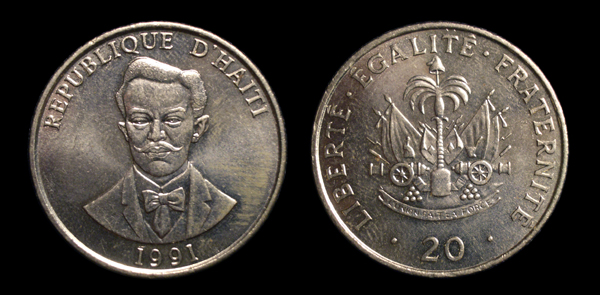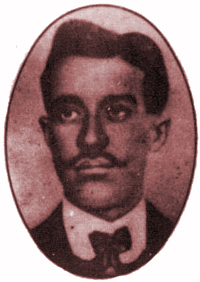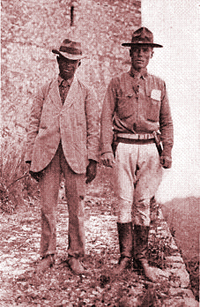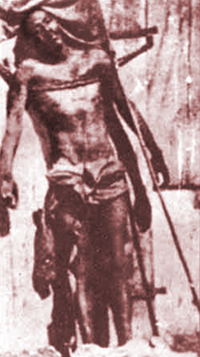
20 CENTIMES COIN - HAITI - CHARLEMAGNE MASSENA PERALTE
(KM 152)
Date: A.D. 1991
Obverse: Portrait facing - REPUBLIQUE D'HAITI 1991
Reverse: Cannons, flags, palm and phgrygian or liberty cap - LIBERTE EGALITE FRATERNITE L'UNION FAIT LA FORCE - 20
Second lieutenant Herman H. Hanneken
The body of Charlemange Peralte on display |
Haiti is a small Caribbean country that shares the island of Hispaniola with the Dominican Republic. The island of Hispania was discovered by Christopher Columbus and became a Spanish Colony until fear of pirate attacks caused Spain to abandon the northern and western shores. This area was eventually colonized by France and became a highly profitable possession with the help of a large imported slave populated brought there to boost the work force as the native population died of western diseases. After several attempts at overthrowing colonial rulers, Haitian rebels finally defeated the forces of Napoleon at the Battle of Vertières and declared Haiti a free nation exalting the Revolutionary Jean Jacques Dessalines as Haiti's first emperor in 1804. Haiti was the first independent black republic, and the only nation ever to be formed from a successful slave revolt. It would go on to support abolitionist movements throughout the Americas including the United States. Haiti's history as an independent nation would be turbulent facing many problems related to class struggles and poverty that still exist today. Charlemagne Masséna Péralte: This is a coin depicting Charlemagne Masséna Péralte born in 1886 in the city of Hinche to a family of moderate wealth of Dominican ancestry. Péralte rose to the office of military chief presiding over the city of Léogane when the US Marines invaded Haiti in 1915. Instability in the form of a rebellion against an oppressive government in Haiti threatened American business interests in the country. In response, President Woodrow Wilson sent 330 U.S. Marines to Port-au-Prince in 1915 with the specific order to the invasion commander, Admiral William Deville Bundy, to "protect American and foreign interests” though a more official reason was to protect the unstable country from German influence. Within six weeks, the United States controlled Haiti. For the next nineteen years the US would govern that nation as an occupying force. During this period, the government of Haiti was effectively under the control of the U.S. Marines whose commanders served as administrators in the provinces. A mulatto federal government was given authority with the U.S. government retaining the power of veto as well as introducing a constitution written by then Assistant Secretary of the Navy Franklin D. Roosevelt. The occupation of Haiti brought some improvement to its infrastructure. Roads were improved and expanded but it was at the expense of the native population through the use of forced labor gangs under control of armed guards who were permitted to shoot anyone who fled compulsory service. This was seen by most as Slave Labor thus garnering the hatred of the rural classes whose ranks filled these work gangs. The US occupiers also restructured the education system which involved the destruction of the existing system of "Liberal Arts" education inherited from the French and replaced it with an emphasis on vocational training thus garnering the ire of the elite. Haiti had a rather ridged pre-existing class system with blacks at the low end and Mulattos occupying the elite upper class. The white occupiers who saw little difference between the 2 classes treating both with equal contempt which further angered the mulatto elite who had previously enjoyed a higher standing in society and saw themselves as superior to the larger black population. Péralte, refusing to work with what he saw as invaders, resigned from his position and returned home to protect his family's land and to resist the occupation. In 1917, he was arrested for assaulting the home of an American officer stationed there and was sentenced to five years of forced labor. He escaped captivity and gathered a group of nationalist rebels called “Cacos” to escalate opposition to US occupation. The Cacos proved to be a formidable force causing the occupation forces to call for more troops to battle the guerilla fighters. Péralte eventually declared a provisional government in the north of Haiti but in the end he was betrayed by one of his officers, Jean-Baptiste Conzé, who led disguised Marine, second lieutenant Herman H. Hanneken, to the rebel camp who in turn shot Péralte in the heart during the short skirmish that ensued. US troops took a picture of Charlemagne Péralte's dead body tied to a door and distributed it throughout the country to demoralize the resistance but the grizzly photo had the opposite effect. Péralte had fought for the independence of his nation from foreign invaders, was killed at the age of 33, and was now seen as a martyr and a hero. When his remains were unearthed after the end of the US occupation in 1935, his mother was able to identify the corpse because of his distinctive gold teeth. He was given a state funeral and acclaimed a national hero. Second Lieutenant Hermann Hanneken was awarded the Medal of Honor for killing the "chief bandit of Haiti". With World condemnation and internal investigation the United States withdrew from Haiti by 1932 leaving the country in the hands of the Mulatto minority elite resulting in a succession of military-backed dictatorships which would define the next 50 years of Haiti's history. Perhaps the best-known account of the fighting in Haiti comes from Marine Major Smedley Butler, who won a Medal of Honor for his exploits, and went on to serve as commanding officer of the Haitian Gendarmerie. (He later expressed his disapproval of the U.S. intervention in his book, 'War is a Racket'). Recent Events: In 1991 Jean-Bertrand Aristide became the first democratically elected president in Haitian history and was succeeded by Andre Préval who is best known for being the first person in Haiti's history to constitutionally succeed a president and then serve a complete term, leaving office voluntarily at the prescribed time. Every previous president had either died in office, been assassinated, been deposed, overstayed his prescribed term, or been installed by a foreign power. Aristide returned to office in 2001 but was deposed under accusations of scandal In 2004 by armed rebels consisting mostly of paramilitary groups led by ex-U.S. Special Forces agent Guy Philippe. The United States again sent Marines into Haiti. Supreme Court Chief Justice Boniface Alexandre succeeded to the presidency until Elections were held in 2006 and René Préval was again elected president. An unsteady peace was established though Haiti remains a country in turmoil. In 2010 Haiti was struck by a devastating 7.0 earthquake killing hundreds of thousands and leaving at least 1.6 million people homeless. In 2016 it was hit by Hurricane Matthew resulting in further destruction to the country, its people, infrastructure and resources. |



